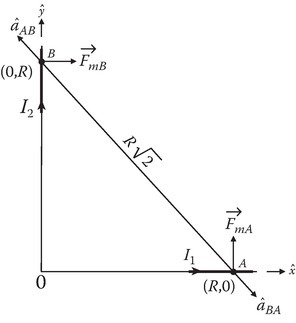]>
Appendix 13B: Electric and Magnetic Forces and Newton’s Third Law
Newton’s third law, as stated in words in many books, is that when one body exerts a force on a second body, the second body simultaneously exerts a force equal in magnitude and opposite in direction on the first body. In this appendix, we will examine it from the viewpoint of electric and magnetic forces [1,2,3].
It is easily shown to be valid in electrostatics by considering the vector form of Coulomb’s law between stationary charges Q1 and Q2. See Figure 13B.1 for an example of the satisfaction of Newton’s third law for the electric force.

FIGURE 13B.1
Geometry to check the validity of Newton’s third law for the electric and magnetic forces.
Let us assume that Q1 is located at A and Q2 is located at B. The electric force at A on Q1 exerted by the electric field of the source Q2 at B is given by
The electric force at B on Q2 exerted by the electric field of the source Q1 at A is given by
We will next calculate the force between two differential current elements to show that Newton’s third law is violated for the case of the magnetic force. Let the first element be located at the point A(R, 0) on the x-axis and the second element be located at B(0, R). We wish to calculate the magnetic force ΔFmA experienced by the element at A. We use the formula derived from the Lorentz force equation (1.6):
where the left-hand side is the differential vector magnetic force at the location of the differential element experiencing the force and B is the external B field at the same location (There should be no confusion in the use of the symbol B. When used as a subscript, it denotes the location of the point on the y-axis.) It then follows that
where is the vector B field at A produced by the current element at B. Assuming that the source currents are steady, from the Biot–Savart law, one can write
From Figure 13B.1,
Thus,
The computation of ΔFmB proceeds on similar lines and results in
From (13B.7) and (13B.8), we conclude that the two forces, while equal in magnitude, are not opposite in direction, thus violating Newton’s third law. In fact, they are perpendicular to each other as shown in Figure 13B.1. A few remarks should be made with regard to the example of the force between two differential current elements discussed above. It is artificial since a differential filamentary current element is used as a help in computing, and any physical filamentary source will be a complete circuit obeying the continuity equation. For example, had we formulated the question as to the force between two parallel, infinitely long filaments, carrying currents in the opposite directions, the repulsive force between them is equal and opposite [3].
A subtle question is whether Newton’s third law will be violated if the charges in the example move with a velocity v [1]. The Lorentz force equation is still valid, but we need to address the method of computing the electromagnetic fields of a moving point charge. This is discussed in detail in Appendix 14G. However, we can note that a moving charge gives rise to time-varying electric field and magnetic field and, as per Appendix 13A, gives rise to an electromagnetic momentum. The problem is thus a three-body problem [2] rather than a two-body problem, and Newton’s third law is applicable to a two-body problem only. In any case for nonrelativistic velocities, the magnetic force is much less than the Coulomb force.
